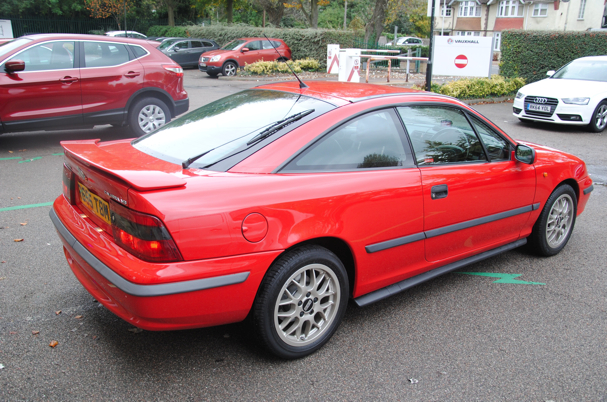Back to the Future with Calibra28 | 10 | 2015

WHAT CONSTITUTES MODERN classics or moderately collectable cars occupies heated bar room debate among petrol heads. So doubtless the stalwarts of Club Calibra lay claim to that status for their beloved Vauxhall, Opel or even Holden of that ilk. (Watch Top Gear's 1990 Vauxhall Calibra roadtest)
And the UK chapter of that organisation reflects Britain’s past, present and future fondness, with 40,438 Calibras registered here during the model’s fairly long lifespan between 1990 and 1999.
Maintaining the practice of planting stylish bodyshells on to the running gear of less exotic higher volume models, Calibra owed its basic format to the repmobile Cavalier, as Ford’s Capri was to Cortina, VW Scirocco to Golf etc.
But the fairly rare 1997 model I borrowed, reg plate R655 TBM, was the swansong special edition SE9 V6 variant, which you could only have in flame red for £20,995, complete with Irmscher rear spoiler, 16-inch BBS alloy wheels, funereal black leather interior and air conditioning.
Instrumentation included oil pressure and battery change gauges plus blessedly simple switchgear and ergonomics.
When it first broke cover in 1990, the Calibra held the title of the most aerodynamic coupe on the market and its styling stands the test of time by turning heads among the cognoscenti, or merely curious. With a shade over 10,600 miles on the clock, Vauxhall Heritage collection’s Calibra was minted.
At this German-built Calibra’s heart is a 2.5-litre, V6 petrol engine shoehorned transversely below the bonnet. The engine was made at Ellesmere Port and, initially in the Cavalier, the first 6-cylinder power unit with a V formation to feature in a Vauxhall. (There’s one for Club Calibra’s Christmas pub quiz.)
Inside, the cabin was a tad sober, with then trendy black on white dials, but there was adequate room for two adults in the back seats plus a fair amount of luggage space in the separate, not hatchback, boot. Seat heaters showed this was no stripped out street racer.
Onboard equipment covered a fairly basic, but effective digital computer, whose functions intriguingly featured a stopwatch for timed sprints to and from Tesco of a weekend, or a birl round the Nurburgring.
Driving the front wheels — and unlike its 2.0-litre turbo stablemate, it never had an all-wheel-drive application — the V6 unit generated, by today’s standards, a modest 169bhp and 167lb/ft of torque. Both figures would not be out of place in a current fairly warm family hatchback.
That propelled it from rest to 62mph in 7.3 seconds and on to a nominal autobahn top speed of 148mph. Arguably the engine would have been better suited to the optional automatic transmission. The five-speed gearchange was a tad gritty and leisurely in operation.
Related: Prices revealed for new Astra Tourer
Merseyside’s finest generated a pleasant, if not raucous, threshing rumble, and over the 200-plus miles covered, fuel consumption hovered between 35 and 39mpg, giving it an under-stressed long-range capability. Box changes from third to fifth demonstrated seamless, tractable power delivery.
It had a pretty drastic CO2 figure of 241g/km, probably not dreadful for its day and the official combined mpg was 27mpg, so I was unusually light-footed … or, just perhaps, there was a glitch in the onboard computer!
With that large V6 lump under the bonnet driving the front wheels, the Calibra tended to understeer. At parking speeds or in tight corners the steering was fairly heavily weighted and the effort involved greater than modern counterparts, including the Astra-based GTC.
To add to Club Calibra’s obscure facts compendium, the Calibra has a link to current Mercedes F1 star Nico Rosberg. His father Keke, 1982 world champion, raced a fire-breathing, all-wheel-drive, turbocharged Calibra racer in German DTM racing during the early 1990s.
It is curious to think that the crude and less stylish Rover 200 “Tomcat” coupe, which tended to dig itself into the tarmac due to excessive torque steer, consistently outsold the more shapely and pragmatic Calibra in the UK.
Just as rumours have persisted about Ford reviving the Capri name, so Calibra has been mooted as a back to the future badge. A quick trawl through Vauxhall model monikers comes up with 17 ending in the letter a. That includes born-again Viva, so never say never.
Related: Vauxhall leads new car sales in Scotland
Keep up-to-date with all the latest news by following us on twitter.com/Scotcars
Hugh Hunston